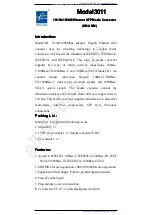
SW Version 2.04
30-January-2009
Page 90 of 128
When setting up a transparent stream, the “Add MPTS” button is
not
used. As with an
SPTS, one simply drags an MPTS from the list of available MPTS’s over to the output
pane. In the output pane, the name of a stream will indicate if it is transparent.
For IP Output, one can configure
Port Settings
. This is as described for SPTS in
4.7.3. For ASI and QAM, make sure to configure sufficient bit rate to transport the
inputs payload
and
null packets. If packets have to be dropped, it is unpredictable
whether this will be done to payload or null packets.
4.7.5
IP Output Redundancy
The IP output redundancy functionality makes it possible to have multiple units with
IP output cards multicasting the same services, and letting the network handle data
loss.
A service may not reach the destination STB for a number of reasons: The source unit
may have an input rate of zero, a descrambling failure, a missing input or output
card, or an error in path to the STB. By adding one or more redundant units with IP
output cards service outage may be prevented given the error is a isolated error.
10.10.30.x
10.10.40.x
10.10.10.x
10.10.20.x
10.10.50.x
10.120.12.1
Distribution network
Main and backup service uses
Same source IP address
OSPF messages
signalling state of service
PIM messages requiring
defined RP point
RP point
Spare IP scrambler
Main IP scrambler
OS
PF,
PIM
, M
CAS
T
10.120.11.1
OS
PF
, P
IM,
MC
AS
T
Dataport Adr:
10.120.11.242
Dataport Adr:
10.120.12
Source Net
ex:
10.10.90.xxx
STB
receives multicast
with source IP address
from network
10.10.90.xxx
Main CA
Spare CA
4.7.5.1
Overview
The IP output card sends the services out as IP multicasts, and relies on OSPF and
PIM messages to configure the network. The routers use this information to route the
multicasts. The network will automatically detect the presence of more than one route
and the redundant packets are thrown away by the routers before they reach the
STBs.
A typical scenario is to broadcast a Digital TV service from two locations using the
same multicast destination address. The network is designed to route one copy only
of the multicast stream to the receiver. In case a source failure occurs, with IP output
















































